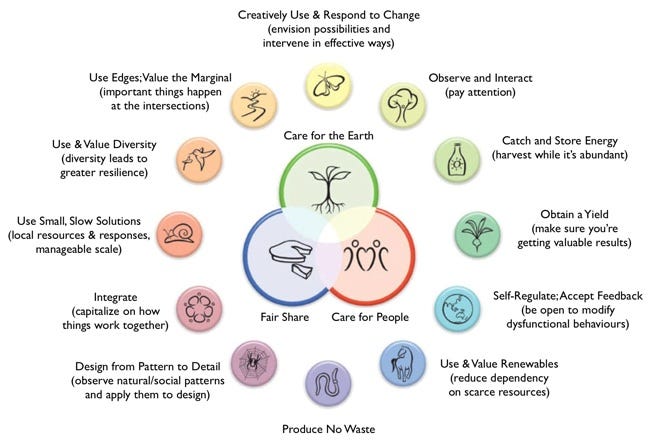We have tens of hectares of land and will develop them according to the permaculture principles in order to contribute to make “Crete green again”. This involves a thoughtful and sustainable approach. The goal is not only to create a thriving ecosystem but also to inspire locals to adopt similar practices, further contributing to a greener and more sustainable environment. Here’s a plan for cultivating our land, creating fruits forest and inspiring the community:
1. Permaculture Design:
- Observation and Analysis: Conduct a thorough analysis of the land, considering factors like soil quality, water sources, wind and sunlight exposure.
- Permaculture Principles: Apply permaculture principles to improve the soil’s fertily, retain the water, design the fruit forests, emphasizing diversity, companion planting, and maximising positive environmental impact.

2. Plants Selection:
- Native and Adapted Species: Choose fruit tree species that are native to Crete or well-adapted to the local climate. This enhances resilience and promotes biodiversity.
- Edible Landscaping: Integrate edible landscaping with a mix of fruit trees, berry bushes, and herbs to maximize productivity.
- We would love to reintegrate old indigenous plants that are not used anymore.
3. Water Management:
- Rainwater Harvesting: Implement rainwater harvesting systems to optimize water use during the dry season.
- Drip Irrigation: Utilize drip irrigation systems to ensure efficient and targeted watering, minimizing water waste.
- We have the long term goal to reach independant water biotope.
4. Soil Enrichment:
- Composting: Establish composting areas to create nutrient-rich soil amendments using organic waste from the community.
- Cover Cropping: Implement cover cropping techniques to protect and enrich the soil between fruit trees.
- Using animal manure by integrating extensive grazing techniques.
5. Community Involvement:
- Workshops and Training: Organize workshops for the local community on sustainable agriculture, permaculture, and the benefits of cultivating fruit forests.
- Hands-On Participation: Encourage locals to actively participate in planting and maintaining the fruit forests, fostering a sense of ownership.
6. Demonstration Gardens:
- Model Gardens: Create small-scale demonstration gardens showcasing different permaculture techniques and the beauty of fruit forests.
- Educational Signage: Install educational signage explaining the ecological benefits and the process of creating sustainable, productive landscapes.

7. Community Events:
- Harvest Festivals: Organize annual harvest festivals to celebrate the abundance of the fruit forests, bringing the community together.
- Interactive Activities: Include interactive activities like fruit picking, workshops, and tastings to engage and educate locals.
8. Collaboration with Local Schools:
- Educational Programs: Collaborate with local schools to incorporate educational programs on sustainable agriculture and environmental conservation.
- School Gardens: Establish small fruit forest areas within school premises, encouraging students to actively participate.
9. Monitoring and Adaptation:
- Regular Assessment: Conduct regular assessments of the fruit forests to monitor plant health, biodiversity, and overall ecosystem well-being.
- Adaptation: Adjust cultivation practices based on observations, incorporating feedback from the community and local experts.
10. Sharing Success Stories:
- Media Outreach: Share success stories through local media, social platforms, and community newsletters to inspire others.
- Open Garden Days: Host open garden days where locals can tour the fruit forests, ask questions, and learn about the project’s impact.
- Creating a line of high quality natural products made directly at the community
By implementing these steps, we aim not only to create an healthy and productive ecosystems but also to inspire a movement towards sustainable and green practices throughout Crete. Through education, collaboration, and community involvement, we hope to set an example that encourages the island to embrace a greener, more productive and harmonious future.